Recommended Reading | Writing Instruction
How Empowering Writers' Instruction Reinforces Reading Development
Reading
The Science of Reading consists of over 40 years of scientific research and evidence about how one learns to read. It is used as a guide for educators to understand how to implement the most effective practices of reading instruction.
The Simple View of Reading is one model used within the SoR. In this model, it shows the subskills needed in Decoding and Language Comprehension to become a skilled reader.

Writing
Just like with reading, there is much research and evidence to show what one needs to be a skilled writer.
The Simple View of Writing or 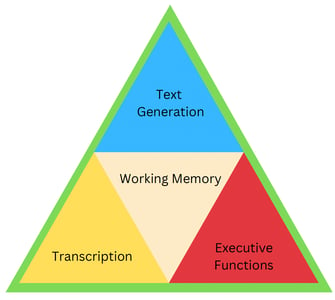 the Not So Simple View of Writing, as it is now known as, is one model that shows the Transcription (Foundational Writing Skills) and Text Generation (Composition Skills) needed to have Skilled Written Expression. The model also shows how Executive Functions play a role in writing and how important it is that we have structures in place to help students be able to self regulate when writing.
the Not So Simple View of Writing, as it is now known as, is one model that shows the Transcription (Foundational Writing Skills) and Text Generation (Composition Skills) needed to have Skilled Written Expression. The model also shows how Executive Functions play a role in writing and how important it is that we have structures in place to help students be able to self regulate when writing.
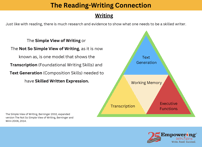
Download the Reading-Writing Connection PDF
At the center of the model is Working Memory. Long-term memory is used during planning and composing and short-term memory during reviewing and revising. This model helps us see just how complex writing is. 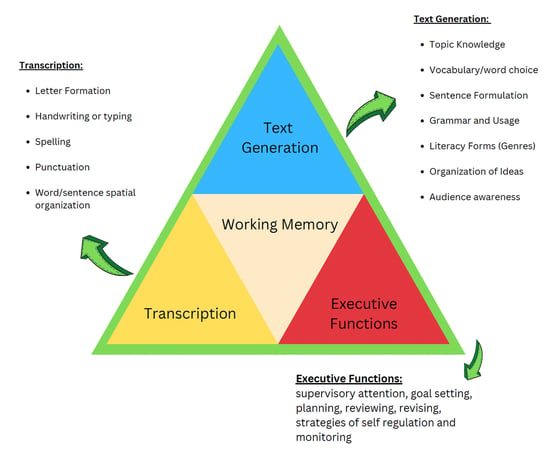
Scientific research shows there is a direct connection between reading and writing. Reading and writing are a reciprocal process. Because of this relationship, it is extremely important that our curriculum and instruction supports both reading and writing.
Decoding and Transcription (Foundational Writing Skills)
Explicit, Systematic, and Cumulative curriculum and instruction in Phonological/Phonemic Awareness, Phonics, and Sight Recognition is imperative for students to learn how to decode.
 These subskills that are worked on in a comprehensive phonics program will also have the subskills for Transcription Skills, also known as Foundational Writing Skills. These curricula should have lessons that not only focus on decoding but focus on encoding (spelling), letter formation, handwriting, punctuation, and word/sentence spatial organizations through dictation.
These subskills that are worked on in a comprehensive phonics program will also have the subskills for Transcription Skills, also known as Foundational Writing Skills. These curricula should have lessons that not only focus on decoding but focus on encoding (spelling), letter formation, handwriting, punctuation, and word/sentence spatial organizations through dictation.
The decoding skills and foundational writing skills should be taught to a level of mastery where students are accurate and automatic in these skills. Fluency is extremely important as it will allow students more cognitive space for comprehension and composition.
Language Comprehension
There are many different programs that focus on language comprehension and eventually reading comprehension in the later elementary grades. These programs should provide comprehensive instruction in building background knowledge and vocabulary through a variety of topics/subjects.
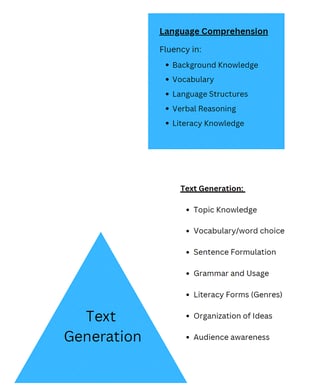 Lessons that grow students’ understanding of literary knowledge, verbal reasoning and language structures should also be a primary focus in these programs. The lessons should also be explicit, systematic and cumulative to build fluency in these higher-level subskills of reading.
Lessons that grow students’ understanding of literary knowledge, verbal reasoning and language structures should also be a primary focus in these programs. The lessons should also be explicit, systematic and cumulative to build fluency in these higher-level subskills of reading.
These skills are growth constructs that continue to grow throughout our lifetime. Continued instruction to build these skills throughout the grade levels is critical to deepen comprehension.
So, what is the missing piece in this connection between reading and writing?
Often the missing piece is explicit, systematic and cumulative instruction in text generation or composition. While many phonics programs provide this type of instruction for the mastery of foundational writing skills, that is often not the case for composition skills.
Research shows that students need writing instruction in both foundational writing skills and composition. The amount of instructional time given to each of these components of writing is dependent on the grade level and needs of the students. Phonics programs spend 20-30 minutes (depending on the grade level) of instruction time on building encoding, handwriting, etc., but often times the mastery of higher-level skills for composition is left to chance in comprehension programs.
What is typically seen is a focus on mere writing tasks with no true instruction on how to compose. Scientific research shows that students should also receive 20-60 minutes (depending on the grade level) of instruction in composition that includes teacher modeling, guidance and application.
Empowering Writers- The Missing Piece!
Through whole class instruction starting with published examples 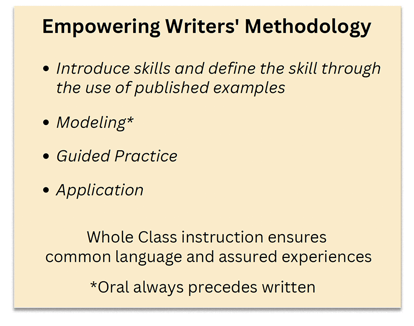 focusing on a specific skill, to modeling the skill, to guided practice to application, Empowering Writers offers curriculum and instruction that is explicit, systematic and cumulative.
focusing on a specific skill, to modeling the skill, to guided practice to application, Empowering Writers offers curriculum and instruction that is explicit, systematic and cumulative.
How Empowering Writers' Approach to Writing Instruction Reinforces Reading Development
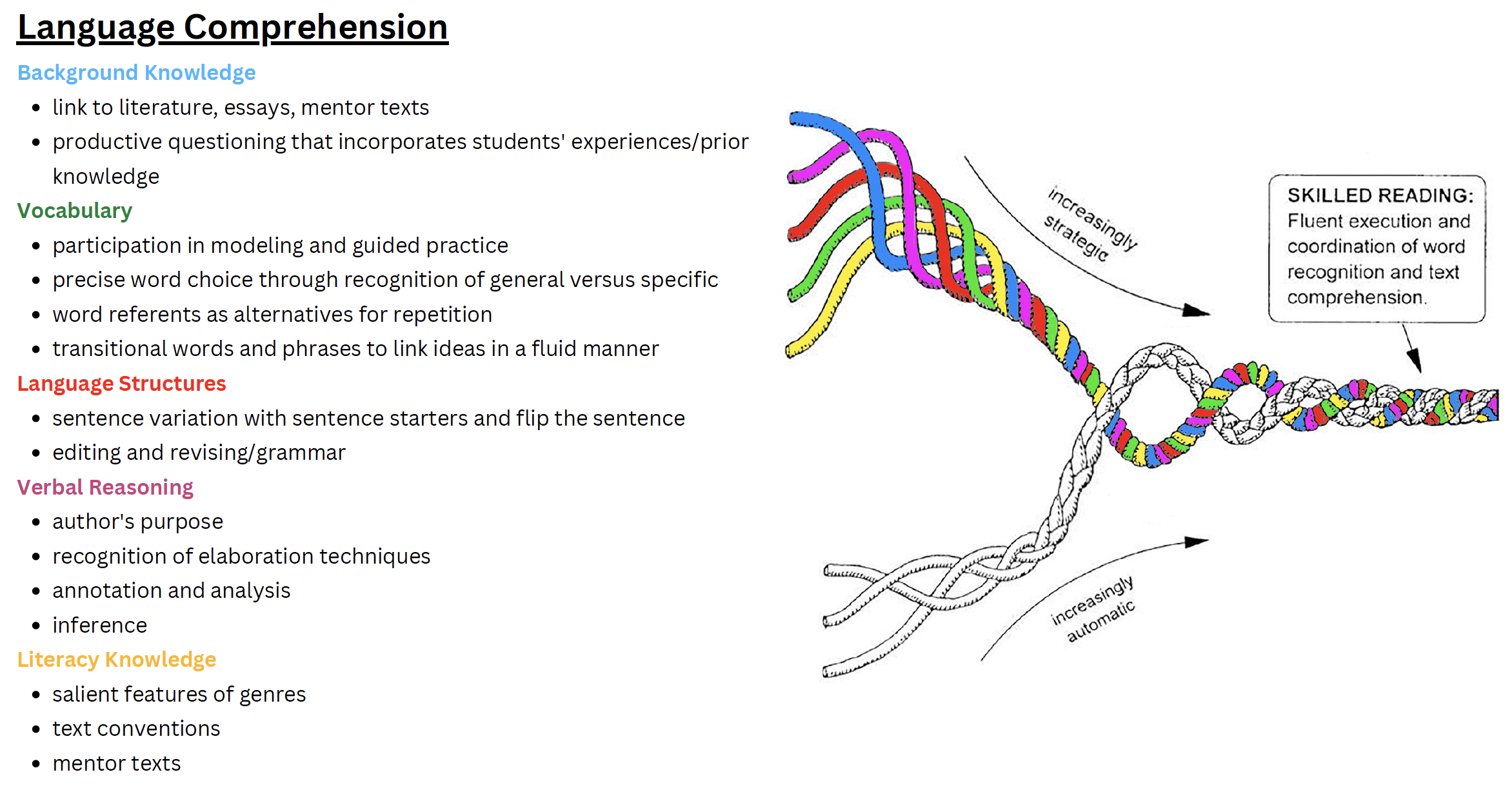
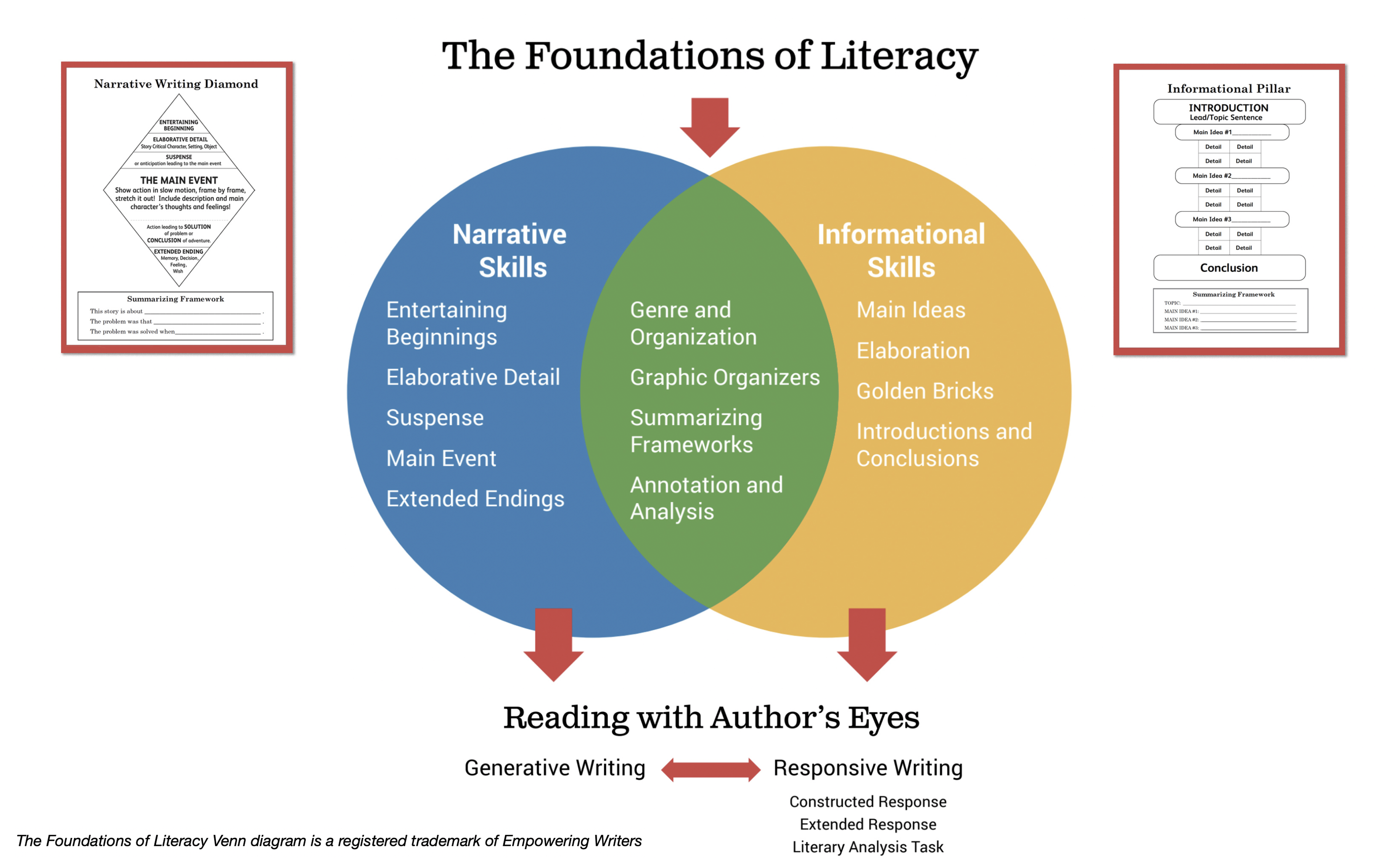
How does Empowering Writers meet the curriculum and instructional needs to teach each of the subskills of Text Generation (Composition) and Executive Functioning?
Let’s take a look!
Text Generation (Composition)
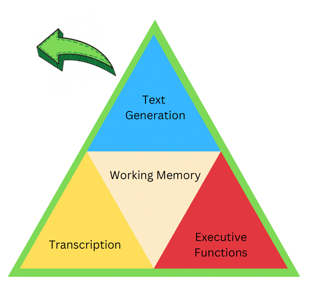 Topic Knowledge
Topic Knowledge- Vocabulary/word choice
- Sentence Formulation
- Grammar and Usage
- Literacy Forms (Genres)
- Organization of Ideas
- Audience awareness
Literary Forms (Genres):
The Literacy Launch in Empowering Writers provides a reading/writing connection that is the bedrock for the curriculum. The lessons in the Literacy Launch provide students with a foundational knowledge of how narrative, informational and opinion genres work by providing specific graphic organizers to use when working with each of the genres.

Recommended Reading:
The Foundations of Literacy - the Literacy Launch
Students are also taught strategic reading skills and annotation skills on how to identify important elements within each genre. By setting this foundation, students are more easily able to take these strategies to their own writing.
There are also other lessons within the Literacy Launch that deepen students understanding of verbal reasoning skills and literary knowledge in reading. The heart of Empowering Writers is found in these lessons, a true connection to reading to help students become better writers.
Download the Reading-Writing Connection PDF
Organization of Ideas:
First introduced in the Literacy Launch, the graphic organizers used for Narrative, Informational, and Opinion writing in Empowering Writers are the framework of the organizational skills taught for each of the genres. Throughout the EW curriculum, there is a section full of explicit lessons over each part of these organizers.
In the Narrative Skills curriculum students are given direct instruction through a variety of lessons on Beginnings, Main Events, and Endings that provide students with the valuable skills they need to produce a well-organized Narrative text.
In the Informational & Opinion Skills curriculum, students learn how to create main ideas/reasons, introductions and conclusions through explicit instruction through modeling, guided practice and application to ensure students can create efficient and effective informational and opinion writing pieces.
Topic Knowledge:
Empowering Writers lessons are filled with experiences that are familiar to students and also build background knowledge around topics through virtual field trips. The writing tasks are around common topics that students can easily access their background knowledge to apply to the topic they are writing about.
In addition, Empowering Writers works with districts that have comprehension programs to align their comprehension curriculum with the Empowering Writers curriculum for a seamless approach in applying topic knowledge in reading to students’ writing.
Vocabulary/Word Choice:
The Elaborative Detail section in the Narrative Skills curriculum and the Elaboration-Detail Generating Questions section in the Informational & Opinion Skills curriculum provide a multitude of explicit lessons to help students with vocabulary and word choice. These elaboration lessons are what set Empowering Writers apart from other writing curriculums.
From lessons that teach students how to use specific examples and stay away from overly general words, to lessons using the detail generating questions to showing vs. telling, these elaboration lessons provide instruction and opportunity for students to create writings that are not only organized well but also provide a true picture of what they are writing about through word choice and vocabulary.
Sentence Formation:
For grades K-2, Empowering Writers A Sentence A Day curriculum provides explicit instruction on how to create complete sentences teaching students about the subject (who/what) and the predicate (doing/describing), capital letters and end punctuation. Throughout these younger grades, students are also taught other grammar and usage skills through these lessons as well.
Throughout the Empowering Writers curriculum, sentence stems are used to provide scaffolding to help students formulate complete sentences when writing.
Grammar and Usage:
For grades 3-7, Empowering Writers Editing, Revising and More curriculum equips teachers with a wide array of explicit lessons on different skills involving grammar and usage.
Each unit in the curriculum provides lessons on a specific skill that can be taught and then easily applied to the students’ writing during the Revising and Editing stages within the Empowering Writers genre specific curriculum.
Audience Awareness:
Through authentic writing tasks and analyzing writing prompts in the Empowering Writers curriculum, students are taught to be aware of their audience when writing for a specific genre.
Students are also instructed on how to determine what they are being asked to write about by analyzing prompts looking for the givens and variables in the prompt.
Executive Function:
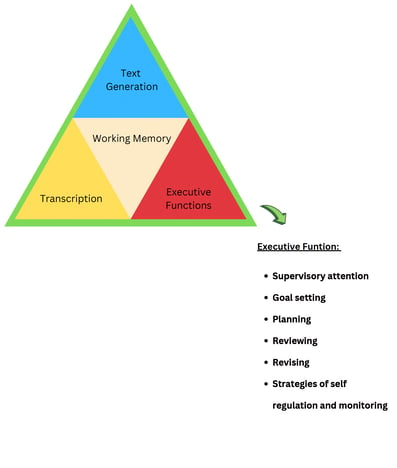 The Empowering Writers approach has many structures in place to help students with goal setting, planning, reviewing, and revising. These structures are embedded in all of the lessons in Empowering Writers.
The Empowering Writers approach has many structures in place to help students with goal setting, planning, reviewing, and revising. These structures are embedded in all of the lessons in Empowering Writers.
Students are taught to use graphic organizers/planning guides specific to different genres to help them with not only goal setting, planning, reviewing and revising but to also be able to self monitor and regulate when writing on their own.
These structures are used over and over again throughout the curriculum which provides students with the ability to internalize these structures to help free up cognitive space to focus on composition.
Citations
- Yusra Ahmed, Shawn Kent, Paul T. Cirino & Milena Keller-Margulis (2022) The Not-So-Simple View of Writing in Struggling Readers/Writers, Reading & Writing Quarterly, 38:3, 272-296, DOI: 10.1080/10573569.2021.1948374
- Kim YG, Schatschneider C. Expanding the developmental models of writing: A direct and indirect effects model of developmental writing (DIEW). J Educ Psychol. 2017;109(1):35-50. doi: 10.1037/edu0000129. PMID: 28260812; PMCID: PMC5330285.
- MiMTSS, Professional Learning Session, October 6, 2022 presentation by Amy Siracusano, Literacy Consultant, Readsters, LLC.